What Is Tonification And How Is It Used In TCM ?
- What does tonification treat?
- How is tonification applied?
- What are the methods of tonification?
- How does tonification work?
Under functioning of the body's structure, organs, or entirety is an important feature of disease development. Traditional Chinese Medicine (TCM) regards these pathological states as a deficiency of healthy energy or asthenia syndrome. This deficiency can result from congenital and acquired factors; congenital factors indicate abnormal conditions present at birth, while acquired factors indicate things like improper diet, emotional disturbance, indulgence, chronic and major illness, childbirth, environmental influences, and aging.
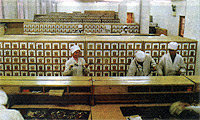
Tonification is a therapeutic method that aims to nourish and replenish the qi (vital energy), blood, yin and yang of the body when they are deficient or weak. It is applicable to one or several of the organs, or one of the qi, blood, yin and yang, or the weakness of all of them as a whole. This is a method, unique to TCM, to sustain and restore the harmony of the body. Although the theories of TCM have a rich philosophical and theoretical background, it has also spawned many practical treatments that can relieve human suffering from a minor irritation to a potentially life-threatening situation. The ways of tonifying body may include the use of diet, herbal preparations, acupuncture, massage and sexual activities.
What does tonification treat?
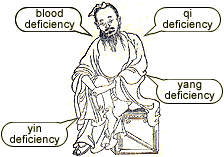 Four basic kinds of deficiencies can affect health and require tonification. Tonification is mainly used to treat a particular deficiency in the body. Symptoms of an asthenia syndrome vary according to the cause, degree of deficiency, and organs involved. It is important to first address the underlying deficiency before applying the appropriate tonification method in order to obtain the maximum benefit for the patient. A deficient condition usually falls into the following categories:
Four basic kinds of deficiencies can affect health and require tonification. Tonification is mainly used to treat a particular deficiency in the body. Symptoms of an asthenia syndrome vary according to the cause, degree of deficiency, and organs involved. It is important to first address the underlying deficiency before applying the appropriate tonification method in order to obtain the maximum benefit for the patient. A deficient condition usually falls into the following categories: 1. Qi deficiency
Qi (vital energy) can be interpreted as the "life energy" or "life force," which flows within us. It can also sometimes refer to the physiological functions of organs and meridians. Qi deficiency manifests as under-functioning of the entire body or certain organs, especially in the respiratory and digestive systems. It usually occurs in cases of chronic illness, improper diet, weakness of old age, physical overstrain and injury. Clinical symptoms include dizziness, blurred vision, shortness of breath, reluctance to speak, fatigue, and spontaneous sweating. The tongue is pink and pulse is weak. TCM physicians usually focus on boosting the lungs and spleen in these situations.
2. Blood deficiency
Blood is viewed simply as the red fluid inside the blood vessels that provides nutrition for the body. The nutrients transported by the blood are not restricted to physical materials only. Its meaning can be extended to anything that provides nourishment to the body, thus blood deficiency leads to inadequate nourishment of the body. this type of deficiency is closely related to problems of the heart, liver, and spleen; common symptoms include pale or sallow complexion, pale lips and nails, dizziness, palpitations, insomnia, numbness in limbs, and in women there may be an abnormal menstrual period. On examination, the tongue is pale and the pulse thready and weak. This kind of deficiency is usually due to blood loss and the body fails to meet the supply; or spleen weakness that fails to produce sufficient blood, or chronic illnesses that consumed too much blood.
3. Yin deficiency
Yin and yang theory is usually used to describe how the body works and how disease occurs, yin and yang represent two opposite yet complementary aspects of objects. For the whole body, yang refers to the functional systems of body whereas yin refers to the physical structures of body. Disharmony between the two aspects is the cause of disease or physiological disorders. When yin deficiency occurs, the organs will become hyper-functioning (a relative hyperactivity of yang inside the body), leading to exuberance and congestion of heat energy. This deficiency is manifested by dizziness, blurred vision, flushing, dryness in the mouth and throat, night sweating, hard stools, tinnitus (ringing of the ears), dry eyes, bright red tongue (with or without fur), and the pulse is thready and rapid. The causes and certain particular symptoms vary with involved organs.
4. Yang deficiency
Yang deficiency reflects an insufficiency in the body's functionality resulting in a slower metabolism, and is manifested by an internal exuberance of coldness. Symptoms include pale and somber complexion, cold body and limbs, aversion to coldness, desire for warmth, withered spirit, drowsiness and lethargy, a pale tongue, and deep and weak pulse. The causes and symptoms vary with involved organs.
Below are yin and yang signs of the body:
| Body signs | Yang signs present with yin deficiency | Yin signs present with yang deficiency |
| Face/Body | Red face, fever, hot feeling, agitated and active manner | Pale face, low spirit, feels cold, cold limbs, tired and weak |
| Voice/Breathing | Coarse and strong voice, coarse breathing, dry mouth, thirsty | Low voice, reduced appetite, flat taste in mouth, lack of thirst, shortness of breath |
| Urine/Stool | Yellow urine, foul smelling stool, constipation | Copious and clear urine, loose stools |
| Tongue | Red and scarlet tongue or yellow and black moss present on tongue | Pale and swollen tongue with white fur |
| Pulse | Rapid and floating, flooded and strong, slippery and full pulse | Slow and sinking, weak, frail pulse |
How is tonification applied?
"Deficiency should be treated by tonifying therapy" is the basic principle of tonification. The Plain Questions has defined deficiency as being caused by a "depletion of essence," which can be interpreted as insufficiency of healthy energy, making it appropriate for tonifying therapy.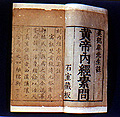 Choosing an appropriate tonification therapy will depend on several factors. It is important to note that traditional Chinese thinking sees an individual as part of nature with which he or she interacts. Climatic and environmental influences cannot be overlooked in treatment. For example, a special tonification therapy may be used to prevent a deficiency that commonly occurs in a particular season. Tonification can, therefore, be used as an illness or disease preventing measure. Specific remedies are designed according to the differential diagnosis and holistic concept of TCM, and following guidelines should also be noted:
Choosing an appropriate tonification therapy will depend on several factors. It is important to note that traditional Chinese thinking sees an individual as part of nature with which he or she interacts. Climatic and environmental influences cannot be overlooked in treatment. For example, a special tonification therapy may be used to prevent a deficiency that commonly occurs in a particular season. Tonification can, therefore, be used as an illness or disease preventing measure. Specific remedies are designed according to the differential diagnosis and holistic concept of TCM, and following guidelines should also be noted: 1. Tonification in accordance with seasons
Tonic remedies should be chosen according to climatic changes or seasons; the Yellow Emperor’s Classic of Internal Medicine has a famous phrase: "nourishing yang in spring and summertime, nourishing yin in autumn and wintertime." TCM believes changes in the external environments are closely related to movement of qi inside the body, so it is important to take account of climatic changes when choosing a remedy. TCM physicians usually apply the following rules:
- Spring is suitable for the lifting method: to promote yang qi, induce sweating and expel cold evils; a sample herb is ephedra;
- Summer is suitable for the clearing method: using herbs with a cold or cool property to clear away the heat or fire evils and promote body fluid metabolism; a sample herb is lotus;
- Autumn is suitable for the general enhancing method: using tonic herbs with neutral and mild properties to enhance the overall body functions, so as to facilitate the recovery from any weakened condition; a sample herb is ginseng;
- Winter is suitable for the nourishing method: using herbs with moist and nourishing properties to clear away body dryness and keep warmth for winter days. A sample ingredient is spot deer horn product.
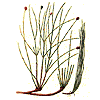 Ephedra Ephedra |
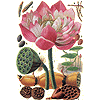 Lotus |
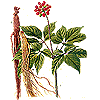 Ginseng Ginseng |
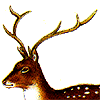 Spot deer horn |
2. Tonification in accordance with locality
Tonic remedies should be chosen according to geographical regions. As claimed by the Yellow Emperor’s Classic of Internal Medicine:"treatment in accordance with local climate and living habits." Traditionally, physicians like to use cooling tonics in the southern regions of China, and warming tonics in the northern regions of China. This is due to the difference in physical constitutions of the people, and also the climate and geographical influences. The dosages and types of herbs selected to treat deficient conditions may also vary, depending on the availability of the medial substances in a given region.
3. Tonification in accordance with individuality
Tonic remedies should be chosen according to individual constitutions; as claimed by the Yellow Emperor’s Classic of Internal Medicine: "There are 25 types of yin yang people." Modern physicians have classified people into different body types according to different constitutions, such as normal, red-heat, sluggish-cold, fatigue-pale and so on, and thus people have different health needs. It also should be considered their clinical aspects too. For example, the therapeutic aim for the heat type is nourishing yin and expelling heat, for the cold type is invigorating yang and expelling cold, and for the fatigue-pale type is replenishing qi and promoting blood production; gentle approaches to reinforce the overall qi, blood, yin and yang are used for those with a neutral constitution.
4. Tonification in accordance with disease or syndrome
Tonic remedies should be based on individual clinical conditions, referring to TCM differential diagnosis. The type of disharmony pattern should first be identified, and then appropriate remedies are applied to replenish qi, promote blood production, nourish yin or invigorate yang. For example, in emergencies or severe cases, rigorous tonifying in which a larger and stronger quantity of herbs is used to overcome serious condition promptly. However, TCM believes this approach tend to damage the spleen and stomach in the long term, leading to problems in digestion and absorption. Therefore gentle tonifying is more commonly employed; lower dosages used over a long period leads to more desirable effects gradually.
What are the methods of tonification?
Extensive medical experience has shown that various approaches can be utilized to reach the goal of tonification: 
Tonifying by diet: Food and drink are necessities for maintaining functioning and vitality. TCM believes that "inadequate qi will result if dieting for half day, qi depletion will occur if dieting for a whole day." Qi (vital energy) can be interpreted as the life energy of body. TCM physicians emphasized the tonifying effect of diet, since foods and herbs come from same origins, they have similar actions. In TCM practice, food remedies are always regarded as the first line of treatment for
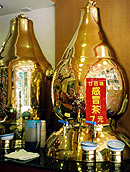 common ailments.
common ailments. Tonifying by herbs: A proper combination of tonics in prescription can result in effective recovery from a deficiency. This is one of most important and common treatments used in TCM. Sun Simiao (581-682 AD), one of the most influential physicians in the history of Chinese medicine, in his best known work Essential Prescriptions Worth a Thousand Gold stated: "If you are in your fifties, keep taking a tonic in all seasons, then you will remain healthy and prolong your lifespan." The book also listed some tonic prescriptions.

Tonifying by acupuncture and moxibustion: Moxibustion method replenishes yang qi and expels coldness; it also invigorates and warms spleen and kidneys so as to boost inborn qi effectively. On the other hand, while some physicians may have doubt about the tonifying effect of acupuncture, a variety of acupuncture techniques have created for the purposes of tonification.
Tonifying by massage: This is achieved by pressing on particular acupoints and through the hand techniques to promote blood circulation, remove stagnations, restore impaired soft tissues and correct bone and joint deformities. In addition, despite being applied to the surface of the body, massage creates signals that affect the transmission of fluids, qi and blood, which helps to regulate the functional state of the internal organs. The usual points selected are those that possess tonic properties such as the guan yuan and zu san li.
 |
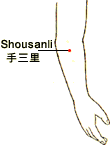 |
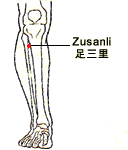 |
Acupoints with a tonic property.
How does tonification work?
From the viewpoint of TCM, tonification mainly works to improve health in three ways: 
1.Regulating the balance of yin yang
Yin yang disharmony is the root of disease and physiological disorders. Disharmony means the proportion of yin and yang is unequal and unbalanced. When one aspect is deficient, the other is in excess, thus the therapeutic strategy is to replenish the deficiency and remove the excess, restoring the body to its natural balance.
2.Promoting the function of organs
When the internal organs work actively, the transformation and transportation of substances throughout the body are thus effective; essence stored in the kidneys will be abundant and full of vitality. In the opposite case, deficiency will develop. Tonification helps to promote organ functioning and recovery from weakness.
3.Stimulating the activities of blood and qi
Blood and qi should be kept in motion for proper circulation. When deficiency occurs leading to a state of stagnation, they can no longer flow smoothly to nourish the body. Tonification invigorates the source of the qi and blood, enhances their production, and improves the overall condition of the body.
Modern research for the mechanism of tonification method started at the beginning of the 20th century, and has obtained substantial pharmaceutical information and understanding about it. Preliminary scientific research has shown that tonification therapies by herbal, dietary, acupuncture or moxibustion can all help to:
- Regulate the function of the adrenal cortex
- Enhance the immune system
- Promote the function of the sex organs
- Improve the renal system
- Improve the respiratory system
- Improve the digestive system
- Regulate the nervous system
- Improve the blood circulatory system
- Improve the metabolism
References
1. Dang Yi, Chinese Nutritional Therapy, Beijing Science Publishing House, 1995. 2. Dang Yi, Peng Yong & Li Wenkui, Chinese Functional Food, New World Press, 1999.
3. Dang Yi, Wang Huizhu & Peng Yong, Chinese Health Tea, New World Press, 1999.
4. Luo Yuankai, ed. TCM Gynecology, Shanghai Science and Technology Publishing House, 1986.
5. Shi Yuguang & Shan Shujian, ed. Diarrhea in Children, Beijing TCM Ancient Books Publishing House, 1988.
6. Tang, Sun Simiao's Qianjin Yifang (A Supplement to the Essential Prescriptions Worth a Thousand Gold or Supplement to Precious Prescriptions). Beijing People's Medical Publishing House Copying, 1955.
7. Yuan, Hu Sihui's Yinshan Zhengyao (Important Principles of Food and Drink), 1st edition collated by Liu Yushu. Beijing People's Medical Publishing House, 1986.
8. Gao Xuemin, ed. Chinese Medicine 1st edition. Beijing TCM Science & Technology Publishing House, 1990.
9. Leng Fangnan, ed. Clinical Study on Chinese Medicinal Diet and Food Therapy 1st edition. Beijing People's Medical Publishing House, 1993.
10. Dang Yi, Eat Grains for Better Health 1st edition, Taiwan Yuan-qi-zhai Publishing House,1994.
11. Gu Chunhau, ed. A Complete Book for Tonification, People's Medical Publishing House, 1996.
12. Huang Mukun, ed. An Essential Book for Tonification, SCMP Book Publishing Ltd., 1993
13. Ou Ming, ed. Chinese-English Dictionary of Traditional Chinese Medicine. Guangdong Science and Technology Publishing House, 1999.
Written By:
Dang Yi (黨毅) MD PhD Professor, Beijing University of Chinese Medicine;
Visiting Professor, Middlesex University, London, UK;
Vice Director, Gourmet Food Institute of Health Care and Nutrition of Beijing, PRC.
Editors:
Angela Collingwood MSN, Integrated Chinese Medicine Holdings Ltd. Rose Tse, Integrated Chinese Medicine Holdings Ltd.
Jennifer Eagleton, BA & MA (Asian Studies)
Raka Dewan, Integrated Chinese Medicine Holdings Ltd.


